Education Down Under – An Australian Perspective
Representing the National Academy for Educational Leadership Wales as part of the Welsh Delegation to Sydney was a career highlight. The ten day visit was packed with school visits, introductions to the New South Wales Education System and included meetings with both their State and National Leadership Institutes. On the way, I got to meet brilliant practitioners and lovely pupils. My remit as an Associate of the National Academy for Educational Leadership Wales was to look at their self-evaluation systems (my commission work) and their approach to leadership development.
Our time in Sydney was organised by LEAP (Leading Educators Around the Planet) and Global International Links based in Cardiff and I encountered more acronyms than marsupials in my ten days there!
The New South Wales (NSW) Education System: The Second Largest in the World
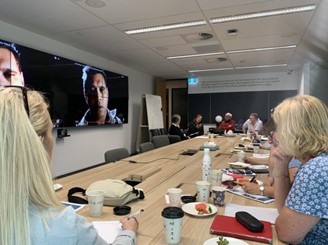
Meeting at the NSW Department of Education
After a jet-lagged welcome dinner we were soon orientated to the NSW system. Its scale became clear: a huge education system of 2,200 principals and schools with 1.2 million learners and some 94,000 teaching staff. A system of huge diversity as well as all too familiar challenges including: post-pandemic pupil attendance, staff recruitment and leadership retention.
The role of DELS (Directors of Educational Leaders) particularly interested me. They act as ex-Principals or currently in post Principals who walk side by side with school leaders. As well as directly managing Principals, they support school improvement and complaints handling. Seeing it in action, I felt it was a valuable way of practically supporting school leadership and research-informed practice.
The state had a clear plan for its schools. One of their targets resonated with me strongly; ‘the need to strengthen trust and respect for the teaching profession and school support staff so that teachers feel valued and supported to perform at their best.’
It is a system with clarity and greater prescription. All schools follow the same School Excellence Cycle and follow the same format for their concise Strategic Improvement Plans. Emphasis has been placed on reducing Principals’ workloads by reporting centrally.
The state funding of private schools is a contentious and divisive issue. It seems huge social inequality exists in the system with 92% of the disadvantaged pupils in public schools and although the system seemed well-funded, Principals now face budget cuts.
School Visits
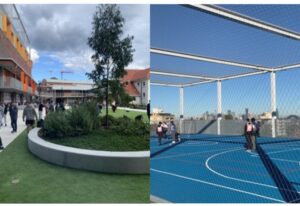
Metropolitan Mosman High School on the North Shore: Basketball roof and classrooms with Harbour Views
Visiting both urban metropolitan schools and suburban schools in what is described as the ‘Cow Pasture Network’ the differences in school contexts became quickly apparent. The State has a more prescriptive approach to its curriculum with all primary pupils experiencing an Explicit Teaching model. The emphasis in these lessons is on key content being learnt with teacher direction; a stark contrast to Wales’ Foundational phase.
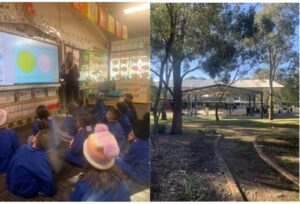
Explicit Teaching Primary Session in the ‘Cow Pasture Network’ of schools with woolly hats in Suburban Sydney.
Older pupils’ school curriculum has placed more emphasis on the job market. Vocational work and career placements have become prevalent. In one secondary school, in addition to their key curriculum, pupils are called upon to carry out building services for the school; in another they are becoming trained baristas with a view to helping them finding employment as they study. The aim is to get pupils practically engaged in relevant career learning.
Listening to the immigration journeys of learners was moving. I reflected on my school and the families who have sought refuge in Wales. Seeing a new build in Sydney’s beautiful North Shores at Mosman High, with its outstanding facilities, gave me ideas for our own new school building in Wales. Schools in Australia provide lots of outdoor sheltered space from the sun; perhaps we should do the same for the rain?!
Acknowledgement
Throughout the visit there was emphasis on Aboriginal culture. Each of the many meetings I attended started with an acknowledgement of the land. We were reminded it always was and always will be aboriginal land. New South Wales’ reconciliation action plan recognises the importance of acknowledging the past. However, following the 2023 Australian Indigenous Voice Referendum, there are wounds and divisions that will need to heal. Education and learning are clearly central to this. A recurring message was that without truthful understanding of history we cannot work together to progress… I loved the celebration of culture in one classroom (pictured below).
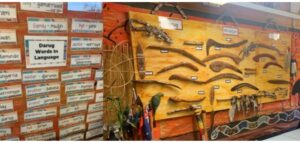
Aboriginal culture in a classroom
Leadership: Familiar Challenges…. Alarming Statistics
New South Wales’s report on the challenges with Principal Well-being had echoes with Wales. Their study that revealed:
- 23% of Principals have left their role since 2019
- 90% are experiencing burnout
- 42% have been in the role fewer than five years.
Despite the alarming statistics it is still a role that reports high levels of job satisfaction!
The system wants to address wellbeing, workload, behavioural challenges and offer support. NSW’s Well-being Strategy for the next three years aims to support staff, lead our people and streamline work. It was interesting meeting people at the coal face; hearing the familiar feeling that so much of the day to day challenges are about “dunnies (toilets), drains and difficult people”.
After having to make it very clear that in Wales we did not work under Ofsted (they had heard some of the press) we were walked through their external validation process. Their process is self-evaluative and Principal’s are supported by their DEL through the process. The validation does not have a judgement, rather focuses on questioning and agreement over the school’s self-evaluation against their School Excellence Cycle. It seems less onerous, light on paperwork yet the Principal School Leader (PSL) will question the Principal with rigour.
NSW Institute for Educational Leadership
Their large Leadership Institute wanted to learn about our National Academy for Educational Leadership Wales and Chief Executive, Tegwen Ellis, and I presented to them on its work. In turn, we were introduced to their programmes, which included a Principals Induction Programme; a Principal Leaders programme; a Senior Leaders programme; and a Coaching and Mentoring programme. The size and scalability of the system enables them to offer many resources for schools to support leadership including the need to identify and nurture leadership early on in school careers.
Curriculum Reform
New South Wales reform began in 2018 with a desire to increase teaching time, focus on real world application, and teach both academic and social skills. They had staggered the approach to reform with subjects changing in different years. Interestingly, NSW looked at the end goal of pupils first, reforming the qualifications prior to the rest of the curriculum. It was fascinating to listen to a Primary Principal whose approach was to look at the end goal of High School when approaching her school’s curriculum content.
Takeaways:
- Does a more centralised system offer greater opportunity and equity for professional learning?
- Would a DEL-like system, with experienced Principals, walking side by side with the Headteacher offer Headteachers in Wales more support and guidance. Would this type of middle tier better support Headteacher recruitment, retention and consistency than Wales’ current structure?
- Can Estyn learn from Australia’s External Validation Process that seems to have been embraced by their Principals?
- Curriculum Reform. Is more guidance and prescription required in Wales? Is there logic in starting curriculum reform by looking at qualifications first?
- Can organisation such as the National Academy for Educational Leadership Wales take on more work around Professional Learning to support Leadership at all levels?
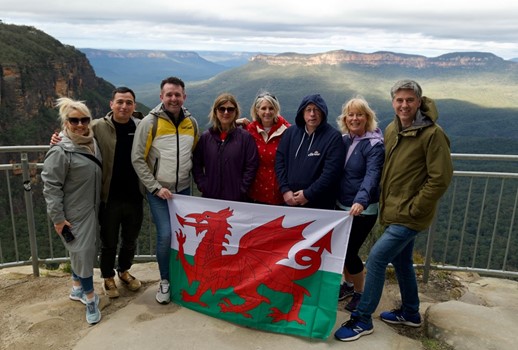
The Welsh Delegation to Sydney on a Weekend Trip to the Blue Mountains
